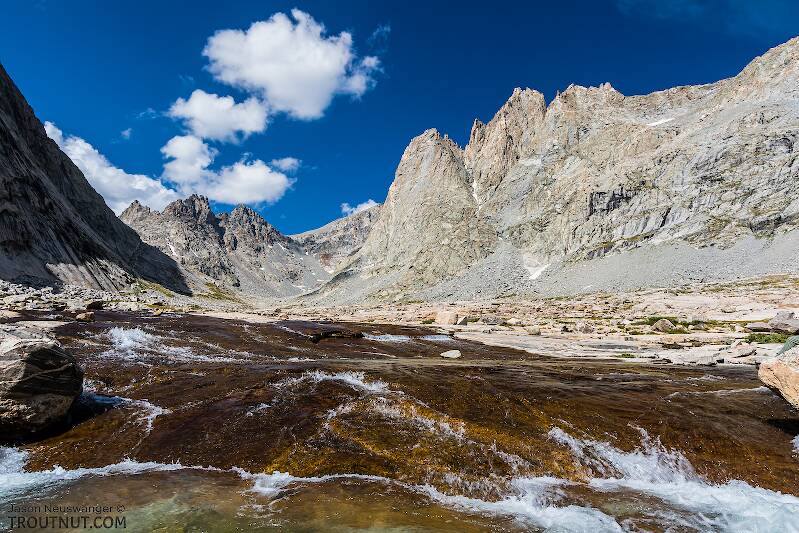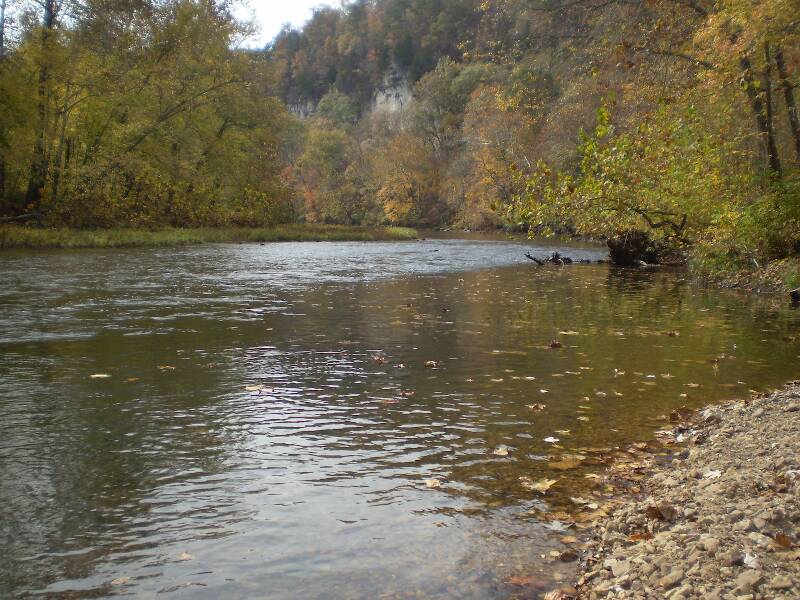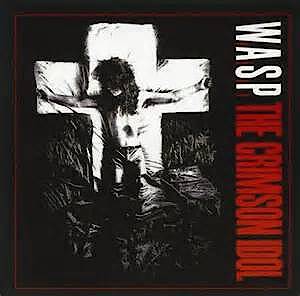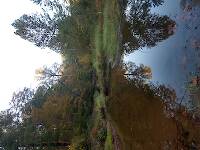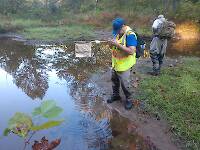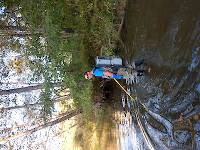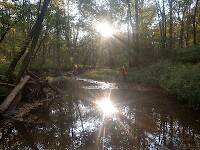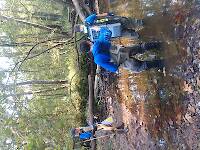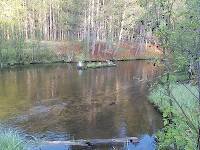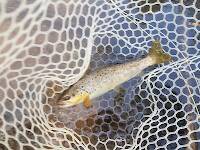
Hex Mayflies
Hexagenia limbata
The famous nocturnal Hex hatch of the Midwest (and a few other lucky locations) stirs to the surface mythically large brown trout that only touch streamers for the rest of the year.
Featured on the forum
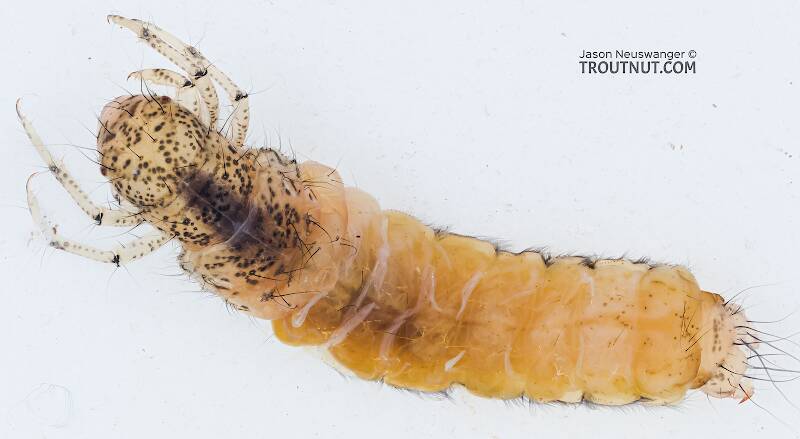
This is a striking caddis larva with an interesting color pattern on the head. Here are some characteristics I was able to see under the microscope, but could not easily expose for a picture:
- The prosternal horn is present.
- The mandible is clearly toothed, not formed into a uniform scraper blade.
- The seems to be only 2 major setae on the ventral edge of the hind femur.
- Chloride epithelia seem to be absent from the dorsal side of any abdominal segments.
Based on these characteristics and the ones more easily visible from the pictures, this seems to be Grammotaulius. The key's description of the case is spot-on: "Case cylindrical, made of longitudinally arranged sedge or similar leaves," as is the description of the markings on the head, "Dorsum of head light brownish yellow with numerous discrete, small, dark spots." The spot pattern on the head is a very good match to figure 19.312 of Merritt R.W., Cummins, K.W., and Berg, M.B. (2019). The species ID is based on Grammotaulius betteni being the only species of this genus known in Washington state.
- The prosternal horn is present.
- The mandible is clearly toothed, not formed into a uniform scraper blade.
- The seems to be only 2 major setae on the ventral edge of the hind femur.
- Chloride epithelia seem to be absent from the dorsal side of any abdominal segments.
Based on these characteristics and the ones more easily visible from the pictures, this seems to be Grammotaulius. The key's description of the case is spot-on: "Case cylindrical, made of longitudinally arranged sedge or similar leaves," as is the description of the markings on the head, "Dorsum of head light brownish yellow with numerous discrete, small, dark spots." The spot pattern on the head is a very good match to figure 19.312 of Merritt R.W., Cummins, K.W., and Berg, M.B. (2019). The species ID is based on Grammotaulius betteni being the only species of this genus known in Washington state.

Troutnut is a project started in 2003 by salmonid ecologist Jason "Troutnut" Neuswanger to help anglers and
fly tyers unabashedly embrace the entomological side of the sport. Learn more about Troutnut or
support the project for an enhanced experience here.
Jmd123 on Sep 17, 2011September 17th, 2011, 8:52 am EDT
I recently went into a favorite tributary of the Rifle River (Klacking Creek) for the first time in 10 years to fish the old beaver ponds that I knew and loved during my West Branch/Skidway Lake-era days. I had great success in those ponds with grasshopper imitations (a modified Joe's Hopper) and had hoped to recapture some of this former glory. Much to my disappointment, all of the beaver ponds were completely gone, no sign even of the old dams (which were likely torn out to discourage any beavers from rebuilding them). This turned the little stream back into, well, a little stream, with large areas of extremely tight cover and shallow waters that were impossible to fish. There were still some fishable holes, out of which I pulled two small rainbows and had a couple more hits that I missed, but I would have to say that fish cover in this stream was substantially reduced in addition to the fishable areas of the stream being extremely reduced (at least by fly rod and perhaps encouraging more worm-dunking). And the old arguments about beaver dams warming the water, well, just doesn't hold water - this is a spring-fed stream that always stayed 5-10 degrees colder than the mainstem of the Rifle even when there were beaver ponds. Perhaps one could argue that some nice gravel beds had been opened up to the fish of the mainstem to spawn on that were blocked by the dams, but the creek always had a nice stretch of gravel beds below the last dam which may have even been kept clean by the dams holding back silt and sand.
I believe there was a thread on here some time ago concerning the topic of beaver dams, but we have a lot of new folks so there should be some fresh opinions on this. OK, boys and girls, what do you think about this?
Jonathon
I believe there was a thread on here some time ago concerning the topic of beaver dams, but we have a lot of new folks so there should be some fresh opinions on this. OK, boys and girls, what do you think about this?
Jonathon
No matter how big the one you just caught is, there's always a bigger one out there somewhere...
GONZO on Sep 17, 2011September 17th, 2011, 10:52 am EDT
Friend or foe? Both, though I'd have to say that manmade dams and development are the far greater foes, especially when they rob headwaters, tribs, and the downstream areas of cold water. In my old stomping grounds in the Poconos, far more once-cold trout streams were warmed by artificial "recreational" impoundments on tributaries than were ever affected by the chisel-toothed woodchoppers. Personally, I'd like to thank the kind folks of the Midwest for helping to restore our PA beaver populations, even though many of those Midwestern imports have (temporarily) ruined my fishing or scared the crap out of me with their close-range tail-slapping antics.
Oldredbarn on Sep 17, 2011September 17th, 2011, 12:26 pm EDT
I'd like to thank the kind folks of the Midwest for helping to restore our PA beaver populations, even though many of those Midwestern imports have (temporarily) ruined my fishing or scared the crap out of me with their close-range tail-slapping antics.
Sorry G. You know how fond some of us Michigan Boys are for "those PA boys"! We didn't want our cousins over your way to mis-out on all the fun. ;)
They are really re-establishing themselves on the upper Au Sable...The busy little shits think they can stop any river no matter how big. We have been seeing more and more little huts along the edges and if you walk by you can hear them grunting in there.
I still can't figure out how they do it. I will see some of their wounds on the lower portion of a tree, pull out my trusty UN World Food Program Swiss knife, and I'm unable to cut even one wood chip from the tree?!
Spence
"Even when my best efforts fail it's a satisfying challenge, and that, after all, is the essence of fly fishing." -Chauncy Lively
"Envy not the man who lives beside the river, but the man the river flows through." Joseph T Heywood
"Envy not the man who lives beside the river, but the man the river flows through." Joseph T Heywood
GONZO on Sep 17, 2011September 17th, 2011, 1:00 pm EDT
Sorry G. You know how fond some of us Michigan Boys are for "those PA boys"! We didn't want our cousins over your way to mis-out on all the fun. ;)
That incident was nearly as intimidating as the time a river otter exited a little Pocono stream right between my legs. I had just stepped into the water from a rhododenron tunnel when a submarine-like wake headed through the shallows toward me. As I was wondering how carp had made their way into this mountain trout stream, the wake materialized into a mature (read "big") otter that shot between my legs, up the bank, and into the same hole in the rhodies that I had just come out of.
Jmd123 on Sep 17, 2011September 17th, 2011, 5:27 pm EDT
Yep, ol' Castor canadensis will make you change your underwear, especially amongst those of us who venture out after dark...but I love their architecture and the trout that they grow for us. Also, as I posted on here some time ago, I saw them restoring proper channel complexity in small coastal Oregon streams that had been diked and channelized to provide horse and cow pasture. And believe me, the coastal cutthroat and coho parr were in those ponds THICK. Great shelter in what were otherwise pretty dinky little creeks...
Jonathon
P.S. Spence, they have some SERIOUS TEETH - they are actually a type of rodent, so think of giant aquatic rats with a taste for tree cambium. In fact, being rodents, if they don't constant chew with those teeth, they will grow too long, first starving them and eventually growing backwards into their skulls (and brains - not a pretty thought).
Jonathon
P.S. Spence, they have some SERIOUS TEETH - they are actually a type of rodent, so think of giant aquatic rats with a taste for tree cambium. In fact, being rodents, if they don't constant chew with those teeth, they will grow too long, first starving them and eventually growing backwards into their skulls (and brains - not a pretty thought).
No matter how big the one you just caught is, there's always a bigger one out there somewhere...
Gutcutter on Sep 18, 2011September 18th, 2011, 4:47 am EDT
Isn't it interesting that Yellowstone was almost completely devoid of beavers until the wolf was re introduced. Now (since 1995) they are on the rise.
I read somewhere that the wolves prey on the elk so much that the elk no longer have the security to eat the majority of young willow and cottonwood trees that are so important to the beaver's diet.
I read somewhere that the wolves prey on the elk so much that the elk no longer have the security to eat the majority of young willow and cottonwood trees that are so important to the beaver's diet.
All men who fish may in turn be divided into two parts: those who fish for trout and those who don't. Trout fishermen are a race apart: they are a dedicated crew- indolent, improvident, and quietly mad.
-Robert Traver, Trout Madness
-Robert Traver, Trout Madness
Taxon on Sep 18, 2011September 18th, 2011, 6:06 am EDT
Good stuff, Tony.
Jmd123 on Sep 18, 2011September 18th, 2011, 8:39 am EDT
Tony, I believe the phenomenon is called "trophic cascade". A predator is introduced (or in the case of Yellowstone, re-established) and it has a cascading effect on many other creatures found within the food web. In Yellowstone, I have read, the predation of the wolves upon the elk has reduced the elk herbivory on riparian vegetation and this has had a most positive effect on the trout, which rely on riparian vegetation for shading (keeping the waters cooler), cover (dead trees and limbs falling into the water), and food (insects falling into the water from the overhanging vegetation). Funny how when you replace a missing part the whole "machine" works better...
I think it was Aldo Leopold who wrote about taking apart an engine. You have all of the parts & pieces spread out before you, and yet you're not sure how every piece functions in the engine. If you don't understand the importance or function of a certain part, would you throw it away and assume that the engine is still going to work well???
Jonathon
I think it was Aldo Leopold who wrote about taking apart an engine. You have all of the parts & pieces spread out before you, and yet you're not sure how every piece functions in the engine. If you don't understand the importance or function of a certain part, would you throw it away and assume that the engine is still going to work well???
Jonathon
No matter how big the one you just caught is, there's always a bigger one out there somewhere...
Taxon on Sep 18, 2011September 18th, 2011, 10:38 am EDT
Jonathan-
This is a trick question, right? :-)
If you don't understand the importance or function of a certain part, would you throw it away and assume that the engine is still going to work well???
This is a trick question, right? :-)
Oldredbarn on Sep 18, 2011September 18th, 2011, 11:48 am EDT
This is a trick question, right? :-)
Roger...How about just tricky? To me wild trout and wilderness and leaving certain places in nature "wild" (say Yellowstone) may not always work in ways we wish but that is just how it goes. We can't have wilderness and get upset every time something happens there we don't like. Otters like fish, Herons like fish, Osprey like fish, Bears like fish etc. etc. I know it might be inconvenient for us after we plan a dream trip to fish the Slough Creek or Lamar and get chased off by a grizzly but we can't have it both ways.
If left alone long enough it will return to mean.
IMHO
Spence
"Even when my best efforts fail it's a satisfying challenge, and that, after all, is the essence of fly fishing." -Chauncy Lively
"Envy not the man who lives beside the river, but the man the river flows through." Joseph T Heywood
"Envy not the man who lives beside the river, but the man the river flows through." Joseph T Heywood
Sayfu
Posts: 560
Posts: 560
Sayfu on Sep 19, 2011September 19th, 2011, 5:08 am EDT
Hope we do recognize some of the great backwater fisheries, and especially tailwater fisheries that dams produce. And that says nothing about regulating water flow that can cause massive flooding damage at times. Anyone follow that California community that their beavers backed up waters throughout the community, causing property damage? And who on this thread, lives along that Touchet River in WA ST.? I have guided, and fished all over that state, and did not know where it was located...had to google it up. Sure like those bug photos.
Jmd123 on Sep 19, 2011September 19th, 2011, 9:29 am EDT
"This is a trick question, right?"
Not if you understand ecology (at least as much as we humans can understand it). And that tends to be the problem - people do NOT understand the connectedness of things in nature, and so think they can modify it to suit their needs without worrying about the consequences. And there are ALWAYS unintended consequences, many if not most of which are bad for both ecosystems and us.
I read an article on trout stream riparian management on the Michigan DNR website a few years ago that made a lot of sense. It said that due to logging in the vicinity of trout streams, there is currently more aspen in riparian zones than there was before the logging era. As aspen is the favored food of beavers in these parts (as well as other places I'm sure), more abundant aspen in riparian zones means more beavers. Too much of any one organisms in any ecosystem is going to cause the detriment of others, so too many beavers equals too many beaver dams, which in excess can warm the waters and block fish movements (and possibly reduce spawning habitats by burying gravel beds). However, I suspect the majority of damage done by beavers is not to the trout streams themsleves but to the ambitions of property owners who live along trout (and other) streams...So you want less beavers? Let riparian zones grow back into coniferous forests and the beavers will have less food.
Jonathon
Not if you understand ecology (at least as much as we humans can understand it). And that tends to be the problem - people do NOT understand the connectedness of things in nature, and so think they can modify it to suit their needs without worrying about the consequences. And there are ALWAYS unintended consequences, many if not most of which are bad for both ecosystems and us.
I read an article on trout stream riparian management on the Michigan DNR website a few years ago that made a lot of sense. It said that due to logging in the vicinity of trout streams, there is currently more aspen in riparian zones than there was before the logging era. As aspen is the favored food of beavers in these parts (as well as other places I'm sure), more abundant aspen in riparian zones means more beavers. Too much of any one organisms in any ecosystem is going to cause the detriment of others, so too many beavers equals too many beaver dams, which in excess can warm the waters and block fish movements (and possibly reduce spawning habitats by burying gravel beds). However, I suspect the majority of damage done by beavers is not to the trout streams themsleves but to the ambitions of property owners who live along trout (and other) streams...So you want less beavers? Let riparian zones grow back into coniferous forests and the beavers will have less food.
Jonathon
No matter how big the one you just caught is, there's always a bigger one out there somewhere...
Sayfu
Posts: 560
Posts: 560
Sayfu on Sep 20, 2011September 20th, 2011, 6:10 am EDT
Here's a funny one on beavers. I guided in Bristol Bay on the Alagnak River in the mid 80's. A huge fear to the angler was to drink water from streams, or rivers that surely had beavers crapping in the water upriver. The thought of getting beaver fever had folks boiling their water. I salmon fish/steelhead fish by putting loops of line in my mouth, and then casting. There was always the thought of getting beaver fever, and I spit a lot, and often when I fished. And there were definitely beavers on the rivers I fished. And, I think the bottomline is....maybe at one time the beavers were the source of Giardia (sp?) up river, but now humans are upstream in good numbers as well.
Gutcutter on Sep 20, 2011September 20th, 2011, 7:56 am EDT
Giardiasis can also be transmitted by other rodents like muskrats. It can be carried by domestic animals and during the rainy season, fields treated with manure can wash the spores (more properly "cysts") into the watershed.
It isn't advisable to drink any water that doesn't come from a tap unless it comes directly from a spring.
Human transmission does occur, but usually from daycare centers or food handlers.
It isn't advisable to drink any water that doesn't come from a tap unless it comes directly from a spring.
Human transmission does occur, but usually from daycare centers or food handlers.
All men who fish may in turn be divided into two parts: those who fish for trout and those who don't. Trout fishermen are a race apart: they are a dedicated crew- indolent, improvident, and quietly mad.
-Robert Traver, Trout Madness
-Robert Traver, Trout Madness
Jmd123 on Sep 20, 2011September 20th, 2011, 8:27 am EDT
I once got away with drinking water directly from a small, spring-fed trout stream, with no bad consequences whatsoever, but I would NEVER do it again! Always use a good water filter!
Jonathon
Jonathon
No matter how big the one you just caught is, there's always a bigger one out there somewhere...
Troutnut on Sep 21, 2011September 21st, 2011, 10:53 am EDT
Lloyd's right: it's both. They can add large pool habitat to streams that otherwise wouldn't have them, and these may also serve as a winter or low-water refuge, so they add some resilience to the system. They can make for great fishing.
On the other hand, there are many negatives:
I think the bottom line is probably that beaver dams are good in systems that flood occasionally and wash the dams out, and bad in extremely stable systems where they get built up so tall and thick that they block fish movement and trap years or decades worth of silt.
On the other hand, there are many negatives:
- They can warm the water (sometimes so slightly it doesn't matter).
- They can block fish passage for spawning or moving between different feeding/winter habitats.
- They can trap silt. This can flat-out kill a trout stream, and over the long term can turn a gravel-bottomed stream into a continuous series of very shallow, mucky-bottomed lakes.
I think the bottom line is probably that beaver dams are good in systems that flood occasionally and wash the dams out, and bad in extremely stable systems where they get built up so tall and thick that they block fish movement and trap years or decades worth of silt.
Jason Neuswanger, Ph.D.
Troutnut and salmonid ecologist
Troutnut and salmonid ecologist
Motrout on Sep 21, 2011September 21st, 2011, 11:38 am EDT
Giardiasis can also be transmitted by other rodents like muskrats. It can be carried by domestic animals and during the rainy season, fields treated with manure can wash the spores (more properly "cysts") into the watershed.
It isn't advisable to drink any water that doesn't come from a tap unless it comes directly from a spring.
Human transmission does occur, but usually from daycare centers or food handlers.
Just as a side note, I'm pretty sure it isn't even advisable to drink water directly from springs...Or so says a sign at just about every spring pool in the Ozark National Scenic Riverways.
My father got a really bad case of Giardiasis from drinking out of an incredibly pristine Alaskan snowmelt stream. So I was taught from pretty early on to be careful about where I drink from. If I'm gonna be away from civilization long enough that I can't carry enough water I always use a filter, even if whatever waterway I'm on has excellent water quality. It's a whole lot safer and they aren't too expensive either.
"I don't know what fly fishing teaches us, but I think it's something we need to know."-John Gierach
http://fishingintheozarks.blogspot.com/
http://fishingintheozarks.blogspot.com/
Jmd123 on Sep 21, 2011September 21st, 2011, 12:03 pm EDT
It's probably like the old Greek philosophy: "everything in moderation". Too many beavers create the problems Jason has outlined above, yet in the right numbers they can considerably enhance the productivity of a small trout stream. Achieving balance in these days of constant human interference, however, is probably damned near impossible - per the example of beaver abundance being excessively high from dominance of their food source (aspen) in riparian zones of trout streams due to human logging of coniferous trees...and maybe we killed off the predators of beaver too (not enough otters controlling the population)??
I do miss those ponds on Klacking Creek, but if it opens up more spawning gravel to trout on the mainstem of the Rifle, well perhaps they won't have to be stocking it so heavily and can rely more on natural trout reproduction. However, those beavers in Oregon were helping salmonids in those small coastal streamns that had modified by human activities, at least in the short run.
Jonathon
I do miss those ponds on Klacking Creek, but if it opens up more spawning gravel to trout on the mainstem of the Rifle, well perhaps they won't have to be stocking it so heavily and can rely more on natural trout reproduction. However, those beavers in Oregon were helping salmonids in those small coastal streamns that had modified by human activities, at least in the short run.
Jonathon
No matter how big the one you just caught is, there's always a bigger one out there somewhere...
Adirman on Sep 21, 2011September 21st, 2011, 1:55 pm EDT
Otters eat beavers?? I didn't know that!!
Jmd123 on Sep 21, 2011September 21st, 2011, 5:39 pm EDT
I don't know for sure, but I wouldn't be surprised if they prey on young beavers. I'm not sure what else would, other than perhaps large great horned owls? If others on here know please chime in.
Jonathon
Jonathon
No matter how big the one you just caught is, there's always a bigger one out there somewhere...
Quick Reply
Related Discussions
Topic
Replies
Last Reply
0
Mar 2, 2021
by Jmd123
by Jmd123
1
Sep 14, 2010
by SlateDrake9
by SlateDrake9

